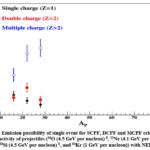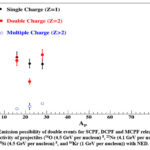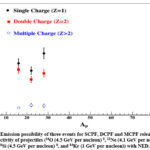Babita Kumari and Manoj Kumar Singh*
Department of Physics, Institute of Applied Sciences and Humanities, GLA University, Mathura, UP, India.
Corresponding Author E-mail: singhmanoj59@gmail.com
DOI : http://dx.doi.org/10.13005/msri.20.special-issue1.03
Article Publishing History
Article Received on : 19 Apr 2023
Article Accepted on : 04 Aug 2023
Article Published : 08 Aug 2023
Plagiarism Check: Yes
Reviewed by: Dr. Alemayehu Getahun Second Review by: Dr. Abel Saka
Second Review by: Dr. Abel Saka Final Approval by: Dr. Sudheesh K. Shukla
Final Approval by: Dr. Sudheesh K. Shukla
Article Metrics
ABSTRACT:
Projectile fragmentation is a rather well-isolated phenomenon within the complex context of highly energetic heavy-ion collisions with a multibaryon system. The projectile fragmentation study reveals the characteristics of the particles release out from the projectile spectator region. The goal of present investigation is to study the emission possibility of single event, double events and triple events for the single charge, double charge and multiple charge projectile fragments. The observation show that the emission possibility of single, double and triple events is depending on the types of the projectile fragments.
KEYWORDS:
projectile fragments; Relativistic heavy ion collision
Copy the following to cite this article:
Kumari B, Singh M. K. Projectile Fragmentation Characteristics of the Events Produced from 84Kr+Emulsion Interaction at 1 a Gev. Mat. Sci. Res. India; Special Issue (2023).
|
Copy the following to cite this URL:
Kumari B, Singh M. K. Projectile Fragmentation Characteristics of the Events Produced from 84Kr+Emulsion Interaction at 1 a Gev. Mat. Sci. Res. India; Special Issue (2023). Available from: https://bit.ly/3QDWU5K
|
Introduction
After the QGP predicted a fresh era of matter, the nucleus-nucleus and hadron-nucleus couplings attracted a great deal of interest from physicists all over the world because they provide a concise description of nuclear nature’s 1-5. Nuclear decentralization is a unique experimental miracle in nucleus-nucleus collision at relativistic energy 1. The study of nuclear fragmentation provides the brief details about the reaction mechanism 1. The interactivity of two different nuclei can be easily described by the PS model 2,3. According to PS model two colliding nuclei can be split in three parts, projectile and target spectator region (PSR & TSR), and participant region (PR). The PSR and TSR are those regions which do not participate in the interaction, while the overlying region is called PR 2. The goal of this work is to investigate the emission feature of the events release from the PSR at relativistic energy.
Experimental Details
The development of nuclear emulsion detector (NED) were execute at GSI Darmstadt, Germany with 84Kr projectile having 1 GeV per nucleon, incident kinetic energy, (i.e. total energy was 84 GeV) 4. The dimension of NED plates was 9.8 x 9.8 x 0.06 cm3 4,5. The NED is a composite target detector 5,6. It contains Br, Ag, N, O, C and H having small percentage of I and S 6. To search the event within NED plates, two well-known (line and volume) scanning techniques were adopted 4,5. In line scanning the event of interest is followed along their track/path till they interact or skip, while in volume scanning the event of interest is scanned strip by strip 5. To scan the event within NED plates, binocular microscope Olympus BH-2 was used 4,5. After scanning and collecting the information of event, they are categorised in three main groups 5. First is projectile fragments (PF), these events are released from the PSR 2,5. Second is target fragments (TF), these events are released from TSR 2,5. Third is shower fragments, these events are released from PR 2,5. Further the PF are divided into three main groups known as singly-charged PF (SCPF), doubly-charged PF (DCPF), and multiple-charge PF (MCPF) 7. The events belongs to SCPF have unit charge (Z=1), the events belongs to DCPF have double charge (Z=2) and the events belongs to MCPF have multiple charge (Z>2).
Results and Discussions
The projectile fragmentation study reveals the characteristics of the particles released from the PSR. In this analysis, the emission possibility of single event, double events and triple events for the SCPF, DCPF and MCPF released from the interactivity of projectiles, 16O (4.5 GeV per nucleon) 8, 22Ne (4.1 GeV per nucleon) 8, 28Si (4.5 GeV per nucleon) 8, and 84Kr (1 GeV per nucleon) with NED are studied and reported.
The emission possibility of single event released in the interactivity of projectiles (16O, 22Ne, 28Si, 84Kr) with NED for SCPF, DCPF and MCPF is shown in figure 1. Figure 1 shows that the emission possibility of single event is highest in case of MCPF and lowest for SCPF. Thus the emission possibility of single event for all three types of PF is showing strong dependency on the types of PF.
 |
Figure 1: Emission possibility of single event for SCPF, DCPF and MCPF released from the interactivity of projectiles (16O (4.5 GeV per nucleon) 8, 22Ne (4.1 GeV per nucleon) 8, 28Si (4.5 GeV per nucleon) 8, and 84Kr (1 GeV per nucleon)) with NED.
Click here to View Figure
|
 |
Figure 2: Emission possibility of double events for SCPF, DCPF and MCPF released from the interactivity of projectiles (16O (4.5 GeV per nucleon) 8, 22Ne (4.1 GeV per nucleon) 8, 28Si (4.5 GeV per nucleon) 8, and 84Kr (1 GeV per nucleon)) with NED.
Click here to View Figure
|
 |
Figure 3: Emission possibility of three events for SCPF, DCPF and MCPF released from the interactivity of projectiles (16O (4.5 GeV per nucleon) 8, 22Ne (4.1 GeV per nucleon) 8, 28Si (4.5 GeV per nucleon) 8, and 84Kr (1 GeV per nucleon)) with NED.
Click here to View Figure
|
Figure 2, shows the emission possibility of double event released in the interactivity of projectiles, (16O, 22Ne, 28Si, 84Kr) with NED for SCPF, DCPF and MCPF. From figure 2 it is clear that the emission possibility of double event is almost same in case of SCPF and DCPF while lowest for MCPF. Therefore the emission possibility of double events is also depending on the types of PF.
Three events emission possibility, released in the interactivity of projectiles,(16O, 22Ne, 28Si, 84Kr) with NED for SCPF, DCPF and MCPF is shown in figure 3. Figure 3 reveals that the emission possibility of three events is highest in case of SCPF and lowest for MCPF. Again we can see that the emission possibility of three events is also depending on the types of PF.
Conclusion
Significant characteristics may be seen in the final-state particles and nuclear fragments produced by the intricate process of nucleus-nucleus impacts. We primarily concentrated our work on understanding the emission possibility of single event, double events and triple events for the SCPF, DCPF and MCPF. The observation of present study shows that the MCPF have highest emission possibility of single event and SCPF have highest emission possibility of triple events. Thus the emission possibility of single, double and triple events is depending on the types of the PF, even the mass and energy of projectiles is different.
Acknowledgements
Author is grateful to the technical staff of GSI Darmstadt, Germany for exposing NED with 84Kr36 projectile.
Conflict of interest
The author(s) declare(s) that there is no conflict of interests regarding the publication of this article.
Funding Source
The author(s) declare(s) that the funding is done by author only.
References
- W. H. Barkas, Nuclear Research Emulsion, Academia Press, London (1963).
- M. K. Singh et al., Two source emission behavior of projectile fragments alpha in 84Kr interactions at around 1 GeV per nucleon, Indian J. Phys., 85(10), 1523-1533 (2011).
CrossRef - F. H. Liu, Multiplicity Distribution of Relativistic Charged Particles in Oxygen-Emulsion Collisions at 3.7A GeV, Chin. J. Phys., 41(5), 486-496 (2003).
- Kajal et al, Emission feature of the singly-charged and doubly-charged projectile fragments emitted in the interaction of 84Kr36 + Em at 1 GeV per nucleon, Int. J. Mod. Phys. E, 31(8), 2250073 (1-8) (2022).
CrossRef - M. K. Singh et al., Emission characteristics of the target fragments at relativistic energy, Int. J. Mod. Phys. E, 31(4), 2250036 (1-10) (2022).
CrossRef - M. K. Singh et al., Study of emission characteristics of the projectile fragments produced in the interaction of 84Kr36 with nuclear emulsion detector at 1 GeV, Chin. J. Phys., 67, 107-112 (2020).
CrossRef - M. K. Singh et al., Emission characteristics of intermediate mass fragments by the 84Kr36 projectile in nuclear emulsion detector at 1 GeV per nucleon, Eur. Phys. J. Plus, 135, 373 (1-8) (2020).
CrossRef - S. Bhattacharyya et al., Projectile fragmentation of relativistic nuclei in peripheral collisions, Eur. Phys. J. Plus., 134, 37 (2019).
CrossRef

This work is licensed under a Creative Commons Attribution 4.0 International License.


 Material Science Research India An International Peer Reviewed Research Journal
Material Science Research India An International Peer Reviewed Research Journal





